
- Home
- Brand
- Model
- 221 Tuna (3)
- E-2c Hawkeye (4)
- Eterna Kontiki (3)
- Eterna Matic (4)
- Eterna Super Kontiki (4)
- F-16 (5)
- F-16c Barak (5)
- F-16i Sufa (8)
- Gamda (3)
- Idf Air Force (3)
- Idf Army Zahal (3)
- Idf Trauma Bandage (5)
- Navigator With Date (15)
- Super Kontiki (3)
- Tank (41)
- Various (12)
- 229 (6)
- 2200 (4)
- 2850 (6)
- 510404 (5)
- Other (3788)
- Religion
- Scale
- Vehicle Make
- Vehicle Type
1948 Jewish IDF ZAHAL Israel MILITARY POSTER Hebrew ISRAEL INDEPENDENCE War Game
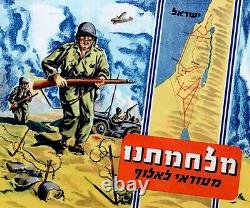
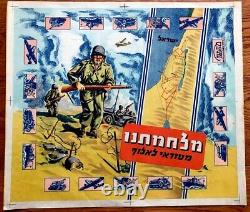
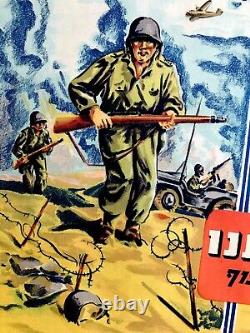
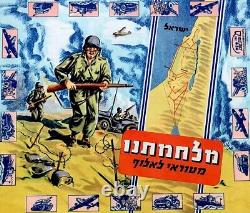

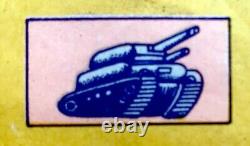
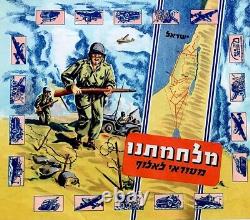
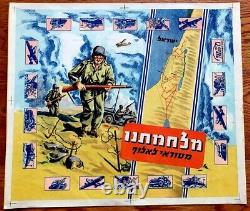
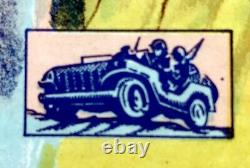

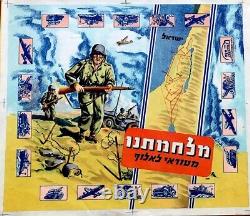
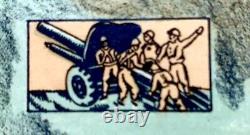
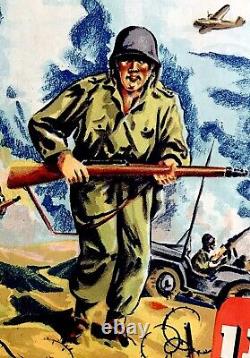
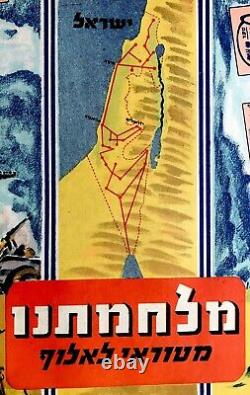
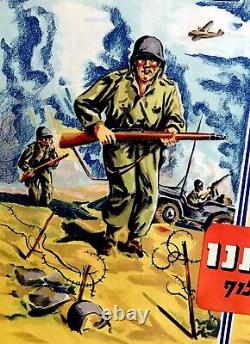
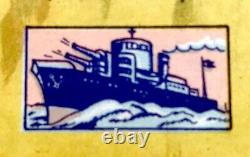
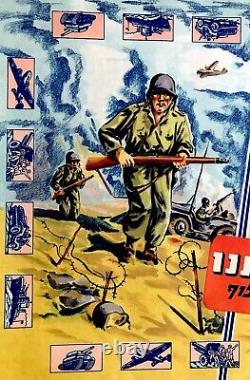



Here for sale is an EXTREMELY RARE illustrated genuine "BARLEVI" item. It's a surviving LITHOGRAPHIC POSTER, Being the uncut BOX COVER of the MILITARY War BOARD GAME which was manifactured and played with in the late 1940's in ERETZ ISRAEL (Then also refered to as PALESTINE).
The background of the game was the 1948 ISRAEL WAR OF INDEPENCENCE and the various pawns were moving along the ERETZ ISRAEL MAP - Participating in HIGHTS and gaining MILITARY RANKS. The game was named OUR WAR - FROM a PRIVATE to a GENERAL.
The BOARD GAME was made by "BARLEVI" in the late 1940's, Right after the times of the BRITISH MANDATE and the WW2 , When the STATE of ISRAEL was established and its 1948 WAR OF INDEPENDENCE. The DESIGNER - CREATOR of this BOARD GAME was the legendary BARLEVI, The main manufactor of GAMES : Board games and CARD GAMES in Eretz Israel - Palestine and later on in Israel state.
A colorful STONE LITHOGRAPHIC Printing. Please note : For sale is only the LITHOGRAPHIC GAME COVER - Before being cut and folded and paster on the game box. The size is 15" x 13". (Pls look at scan for accurate AS IS images). Will be sent in a special protective rigid sealed package.AUTHENTICITY : The POSTER is fully guaranteed ORIGINAL from 1948, It is NOT a reproduction or a recently made reprint or an immitation, It holds a life long GUARANTEE for its AUTHENTICITY and ORIGINALITY. W ill be sent in a special protective rigid sealed package. The Israel Defense Forces (IDF) Hebrew:???????????????????????????
, Tzva HaHagana LeYisra'el (help·info), lit. Defense Army for Israel, commonly known in Israel by the Hebrew acronym Tzahal (???), are Israel's military forces, comprising the ground forces, air force and navy.It is the sole military wing of the Israeli security forces, and has no civilian jurisdiction within Israel. The IDF is headed by its Chief of General Staff, the Ramatkal, subordinate to the Defense Minister of Israel; the current Chief of Staff, since 2007, is Lieutenant General Gabi Ashkenazi. At the order of Defense Minister David Ben-Gurion on May 26, 1948, the Israel Defense Forces were officially formed as a conscript army out of the paramilitary group Haganah, incorporating the militant groups Irgun and Lehi. It served as Israel's armed forces in all the country's major military operations - including the 1948 Arab-Israeli War, the 1956 Sinai War, the 1967 Six-Day War, the War of Attrition, the 1973 Yom Kippur War, Operation Litani, the 1982 Lebanon War, Operation Defensive Wall, the 2006 Lebanon War and Operation Cast Lead. While originally the IDF was operational on three fronts-against Lebanon and Syria in the north, Jordan and Iraq in the east, and Egypt in the south-after the 1979 Egyptian-Israeli Peace Treaty, its activities have mainly been concentrated in southern Lebanon and the Palestinian Territories, including the First and the Second Intifada.
The Israel Defense Forces differs from most armed forces in the world in many ways, including the conscription of women, and the structure, with close relations between the ground forces, air force and navy. Since its founding, the IDF has striven to be a unique army fitting Israel's specific requirements. In 1965, the Israel Defense Forces was awarded the Israel Prize for its contribution to education. [3] The IDF uses several technologies developed in Israel, many of them made specifically to match the IDF's needs, such as the Merkava main battle tank, advanced Hi-Tech weapons systems, and the Galil and Tavor assault rifles. The Uzi submachine gun was used by the IDF until December 2003, ending a service that began in 1954.The IDF also has close military relations with the United States, [4] including development cooperation, such as on the F-15I jet, THEL laser defense system, and the Arrow missile defense system. History Main articles: History of the Israel Defense Forces and Military operations conducted by the Israeli Defense Forces The IDF traces its roots to Jewish paramilitary organizations in the New Yishuv, starting with the Second Aliyah.
The first such organization was Bar-Giora, founded in September 1907. It was converted to Hashomer in April 1909, which operated until the British Mandate of Palestine came into being in 1920. Hashomer was an elitist organization with narrow scope, and was mainly created to protect against criminal gangs seeking to steal property.During World War I the forerunners of the Haganah/IDF were the Zion Mule Corps and the Jewish Legion. After the Arab riots against Jews in April 1920, the Yishuv's leadership saw the need to create a nationwide underground defense organization, and the Haganah was founded in June of the same year. During World War II the successor to the Jewish Legion of World War I was the Jewish Brigade.
The IDF was founded following the establishment of the State of Israel, after Defense Minister and Prime Minister David Ben-Gurion published the order for its creation on May 26, 1948. The order called for the establishment of the Israel Defense Forces, and the abolishment of all other Jewish armed forces. Although Ben-Gurion had no legal authority to issue such an order, the order was made legal by the cabinet on May 31. This was the background for the dispute which led to the Altalena Affair, when following a confrontation regarding the weapons it brought resulted in a battle between Irgun members the newly-created IDF. Following the affair, all independent Irgun and Lehi units were either disbanded or merged into the IDF. The Palmach, a strong lobby within the Haganah, also joined the IDF with provisions, and Ben Gurion responded by disbanding its staff in 1949, after which many senior Palmach officers retired, notably its first commander, Yitzhak Sadeh. The new army organized itself during the 1948 Arab-Israeli War, when Syria, Lebanon, Egypt, Transjordan, Iraq, Saudi Arabia and Yemen declared war on Israel. Twelve infantry and armored brigades were created: Golani, Carmeli, Alexandroni, Kiryati, Givati, Etzioni, the 7th and 8th armored brigades, Oded, Harel, Yiftach and Negev.[6] After the war, some of the brigades were converted to reserve units, and others were disbanded. Directorates and corps were created from corps and services in the Haganah, and this basic structure in the IDF still exists today.
Immediately after the 1948 war, the Israel Defense Forces shifted to low intensity conflict against Arab Palestinian guerrillas. In the 1967 Six-Day War, Israel captured the Sinai Peninsula, West Bank and Golan Heights from the surrounding Arab states, changing the balance of power in the region as well as the role of the IDF. In the following years leading up to the Yom Kippur War, the IDF fought a war of attrition against Egypt in the Sinai and a border war against the PLO in Jordan, culminating in the Battle of Karameh. The surprise of the Yom Kippur War and its aftermath completely changed the IDF's procedures and approach to warfare. Organizational changes were made and more time was dedicated to training for conventional warfare.
However, in the following years the army's role slowly shifted again to low-intensity conflict, urban warfare and counter-terrorism. It was involved in the Lebanese Civil War, initiating Operation Litani and later the 1982 Lebanon War, where the IDF ousted Palestinian guerilla organizations from Lebanon. Palestinian militancy has been the main focus of the IDF ever since, especially during the First and Second Intifadas, Operation Defensive Shield and the Gaza War, causing the IDF to change many of its values and publish the IDF Spirit. The Shia organization Hezbollah has also been a growing threat, against which the IDF fought a full-scale war in 2006. Etymology The name Israel Defense Forces (Hebrew:???????????????????????????
, Tzva HaHagana LeYisra'el, literally "The Defense Army for Israel") was ratified by the Israeli cabinet on May 26, 1948, the day that the order for the army's founding was published by David Ben-Gurion. The main suggested alternative was Israeli Army/Army of Israel (Hebrew:????????????????, Tzva Yisra'el), while others included Jewish Army and Army of the State. The name was chosen for two reasons: because it emphasized that army's role was for defense only, and because it incorporated the name Haganah, the paramilitary organization it was based on. [7] At least three people claim to have coined the name.
The Defense Ministry CEO at the time, David Izre'eli, wrote that he suggested it to Levi Eshkol, who forwarded the suggestion to the cabinet. The Chief of Staff Ya'akov Dori, while not claiming to have personally coined the name, said that it was prevalent among senior army personnel and therefore the only natural name. Ben-Gurion was the third, quoted as saying I gave the name. The name was'Israel Defense Forces'. Among the primary opponents of the name were Minister Haim-Moshe Shapira and the Hatzohar party, both suggesting the name Israeli Army. [7] Organization All branches of the IDF are subordinate to a single General Staff. The Chief of the General Staff is the only serving officer having the rank of Lieutenant General (Rav Aluf). He reports directly to the Defense Minister and indirectly to the Prime Minister of Israel and the cabinet. Chiefs of Staff are formally appointed by the cabinet, based on the Defense Minister's recommendation, for three years, but the government can vote to extend their service to four (and in rare occasions even five) years.The current chief of staff is Gabi Ashkenazi. He replaced Dan Halutz, who resigned from the IDF following the 2006 Lebanon War. A board game is a game in which counters or pieces are placed, removed, or moved on a premarked surface or "board" according to a set of rules.
Games may be based on pure strategy, chance or a mixture of the two and usually have a goal which a player aims to achieve. Early board games represented a battle between two armies and most current board games are still based on beating opposing players in terms of counters, winning position or accrual of points (often expressed as in-game currency). There are many different types and styles of board games. Their representation of a real life situation can range from having no inherent theme, such as Checkers, to having a specific theme and narrative, such as Cluedo. Rules range from the very simple, such as in Tic-tac-toe, to ones which describe a game universe in great detail, such as in Dungeons & Dragons, although most of these are Role-playing games and the board is secondary to the game, serving to visualize the scenario.The length of time it takes to learn to play or master a game can vary greatly from game to game. Learning time does not necessarily correlate with the amount or complexity of rules; some games, such as chess and Go, have simple rules that can still lead to complex scenarios History Board games have been played in most cultures and societies throughout history; some even pre-date literacy skill development in the earliest civilizations.
[citation needed] A number of important historical sites, artifacts and documents exist which shed light on early board games. Some of these include: The Jiroft civilization game boards Senet has been found in Predynastic and First Dynasty burials of Egypt, c. 3500 BC and 3100 BC respectively. [2] Mehen is another ancient board game from Predynastic Egypt. Go is an ancient strategic board game originating in China Patolli is a board game originating in Mesoamerica, and was played by the ancient Aztec. The Royal Tombs of Ur contained, among others, the Royal Game of Ur. They were excavated by Leonard Woolley, but his books document little on the games found. Most of the games he excavated are now housed in the British Museum in London. The Buddha games list is the earliest known list of games. Timeline See also: Category:Years in games and Timeline of chess c. 3500 BC: Senet found under Predynastic Egyptian burials;[1] also depicted in the tomb of Merknera.3000 BC: The Mehen board game from Predynastic Egypt, was played with lion-shaped gamepieces and marbles. 3000 BC: Ancient backgammon set, found in the Burnt City in Iran. 2560 BC: Board of the Royal Game of Ur (found at Ur Tombs) c. 2500 BC: Paintings of Senet and Han being played depicted in the tomb of Rashepes[citation needed] c.
1500 BC: Painting of board game at Knossos. 500 BC: The Buddha games list mentions board games played on 8 or 10 rows. 500 BC: The earliest reference to Chaturaji or Pachisi written in the Mahabharata, the Indian epic. 400 BC: Two ornately decorated Liubo game boards from a royal tomb of the State of Zhongshan in China.
400 BC: The earliest written reference to Go/Weiqi in the historical annal Zuo Zhuan. Go/Weiqi is also mentioned in the Analects of Confucius c. [7] 116-27 BC: Marcus Terentius Varro's Lingua Latina X II, par. 20 contains earliest known reference to Latrunculi[8] (often confused with Ludus Duodecim Scriptorum, Ovid's game mentioned below).
1 BC-8 AD: Ovid's Ars Amatoria contains earliest known reference to Ludus Duodecim Scriptorum. 1 BC-8 AD: The Roman Game of kings is a game of which little is known, and which is more or less contemporary with the Latrunculi. 43 AD: The Stanway Game is buried with the Druid of Colchester. 200 AD: A stone Go/Weiqi board with a 17×17 grid from a tomb at Wangdu County in Hebei, China. [10] 220-265: Backgammon enters China under the name t'shu-p'u (Source: Hun Tsun Sii)[citation needed] c. 400 onwards: Tafl games played in Northern Europe. 600 The earliest references to Chaturanga written in Subandhu's Vasavadatta and Banabhatta's Harsha Charitha early Indian books. 600: The earliest reference to Chatrang written in Karnamak-i-Artakhshatr-i-Papakan. 1283: Alfonso X of Castile in Spain commissioned Libro de ajedrez, dados, y tablas "Libro de los Juegos" (The Book of Games) translated into Castilian from Arabic and added illustrations with the goal of perfecting the work. 1930: Monopoly stabilises into the version that is currently popular. 1980: German-style board games begin to develop as a genre Many board games are now available as computer games, which can include the computer itself as one of several players, or as sole opponent. The rise of computer use is one of the reasons said to have led to a relative decline in board games. [citation needed] Many board games can now be played online against a computer and/or other players. Some board games make use of components in addition to-or instead of-a board and playing pieces.Some games use CDs, video cassettes, and, more recently, DVDs in accompaniment to the game. [citation needed] Psychology While there has been a fair amount of scientific research on the psychology of older board games e.
Chess, Go, mancala, less has been done on contemporary board games such as Monopoly, Scrabble, and Risk. [15] Much research has been carried out on chess, in part because many tournament players are publicly ranked in national and international lists, which makes it possible precisely to compare their levels of expertise. The works of Adriaan de Groot, William Chase, and Herbert Simon have established that knowledge, more than the ability to anticipate moves, plays an essential role in chess-playing.This seems to be the case in other traditional games such as Go and Oware (a type of mancala game), but data is lacking in regard to contemporary board games. [citation needed] Bruce Halpenny, a games inventor said when interviewed about his game, With crime you deal with every basic human emotion and also have enough elements to combine action with melodrama. The player's imagination is fired as they plan to rob the train. Because of the gamble they take in the early stage of the game there is a build up of tension, which is immediately released once the train is robbed.
Release of tension is therapeutic and useful in our society, because most jobs are boring and repetitive. [16] Luck, strategy and diplomacy One way to categorize board games is to distinguish those based primarily upon luck from those that involve significant strategy.
Some games, such as chess, are almost entirely deterministic (the first person to make a move having a slight advantage), relying on the strategy element for their interest. Children's games, on the other hand, tend to be very luck-based, with games such as Candy Land and Snakes and ladders having no decisions to be made.
Most board games involve both luck and strategy. A player may be hampered by a few poor rolls of the dice in Risk or Monopoly, but over many games a player with a superior strategy will win more often. While some purists consider luck to not be a desirable component of a game, others counter that elements of luck can make for far more diverse and multi-faceted strategies as concepts such as expected value and risk management must be considered. The third important factor in a game is diplomacy, or players making deals with each other. A game of solitaire, for obvious reasons, has no player interaction. Two player games usually do not have diplomacy (cooperative games being the exception). Thus, this generally applies only to games played with three or more people. An important facet of The Settlers of Catan, for example, is convincing people to trade with you rather than with other players. In Risk, one example of diplomacy's effectiveness is when two or more players team up against others. Easy diplomacy consists of convincing other players that someone else is winning and should therefore be teamed up against. Difficult diplomacy (such as in the aptly named game Diplomacy) consists of making elaborate plans together, with possibility of betrayal. Luck is introduced to a game by a number of methods. The most popular is using dice, generally six-sided. These can determine everything from how many steps a player moves their token, as in Monopoly, to how their forces fare in battle, such as in Risk, or which resources a player gains, such as in The Settlers of Catan. Other games such as Sorry! Use a deck of special cards that, when shuffled, create randomness. Scrabble does something similar with randomly picked letters.Other games use spinners, timers of random length, or other sources of randomness. Trivia games have a great deal of randomness based on the questions a person gets.
German-style board games are notable for often having rather less of a luck factor than many North American board games. Common terms Although many board games have a jargon all their own, there is a generalized terminology to describe concepts applicable to basic game mechanics and attributes common to nearly all board games. Game board (or simply board)-the (usually quadrilateral) surface on which one plays a board game; the namesake of the board game, gameboards would seem to be a necessary and sufficient condition of the genre, though card games that do not use a standard deck of cards (as well as games which use neither cards nor a game board) are often colloquially included. Most games use a standardized and unchanging board (chess, Go, and backgammon all have such a board), but many games use a modular board whose component tiles or cards can assume varying layouts from one session to another, or even as the game is played. Game piece (or counter or token or bit or mover or pawn)-a player's representative on the game board.
Each player may control one or more game pieces. In some games that involve commanding multiple game pieces, such as chess, certain pieces have unique designations and capabilities within the parameters of the game; in others, such as Go, all pieces controlled by a player have the same essential capabilities. In some modern board games, such as Clue, there are other pieces that are not a player's representative, i. In some games, pieces may not represent or belong to a particular player. Jump-to bypass one or more game pieces or spaces. Depending on the context, jumping may also involve capturing or conquering an opponent's game piece. (See also: Game mechanic: capture) Space (or square)-a physical unit of progress on a gameboard delimited by a distinct border. Alternately, a unique, atomic position on the board on which a game piece may be located while in play (in Go, for example, the pieces are placed on intersections of lines on the grid, not in the areas bounded by the grid lines as is seen in chess). (See also: Game mechanic: Movement) Hex-in hexagon-based board games, this is the common term for a standard space on the board. This is most often used in wargaming, though some abstract strategy games such as Abalone use hexagonal layouts. Card-a piece of cardboard on which instructions are given Deck-a stack of cards Capture-a method in which one removes another players game piece from the board, for example: in checkers if you jump another player's piece, that piece is captured.Categories There are a number of different categories that board games can be broken up into. (2010) Family games like Roll Through the Ages, Birds on a Wire or For Sale 2-player games like En Garde and Dos de Mayo Large multiplayer games like Take it Easy and Swat (2010) Educational games like Arthur Saves the Planet, Cleopatra and the Society of Architects, and Shakespeare: The Bard Game Dexterity games like Tumblin' Dice and Pitch Car Historical simulation games like Through the Ages and Railways of the World See also Card game DVD games List of board games List of game manufacturers Tabletop game [30].

